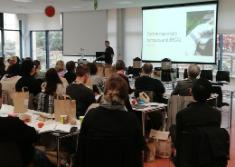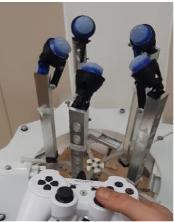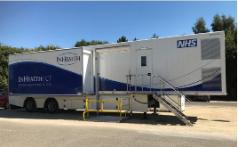Fighting cancer: from the lab to the community
The afternoon started with a talk by PhD student Amy Francis based in Bristol Medical School; alongside her collaborator Colin Campbell (Engineering Mathematics), they are using machine learning techniques to predict unregulated cell division in the human cancer genome. With the help of computer systems that are able to learn and adapt without following explicit instructions, they are using algorithms and statistical models to analyse patterns in data to develop new classifiers to predict the driver or neutral status of genomic variants. By identifying whether genomic changes can turn into tumours, the researchers hope to prevent tumours from forming, or detect cancer in its early stages when it is easier to treat successfully.
Director of the European Cancer Stem Cell Research Institute Matt Smalley and his MSc student Jacob Evans, both based at Cardiff University, are working with veterinarian Grace Edmunds and colleagues at Langford Vets to explore how dogs could be used as models for human breast cancer. As part of this research, the team are slowly building a centralised companion and farm animal tissue and DNA repository (a biobank) with sequencing, genomics and bioinformatics capabilities that could be accessed by other researchers across the country. This resource could be used to identify host genetic determinants of disease susceptibility such as zoonoses (infectious diseases that jump from animals to humans, such as SARS-CoV-2 and avian flu) and cancer. This One Health approach, which provides a holistic view of how humans, animals and the environment all interact together, will inform tissue physiology and pathology in humans and animals. Their project is currently looking at English springer spaniels, who are at higher risk of developing mammary tumours, and whether specific genetic variants affect how the disease develops. This insight could lead to new discoveries in human breast cancer.

Image: Matt Smalley of Cardiff University talking about his work with English springer spaniels, who are at high risk of developing mammary tumours, and how the canine disease could inform human breast cancer
Our third talk was given by Consultant Clinical Oncologist Sarah Hargreaves and Clinical Oncology trainee Nicola Cox. Sarah and Nicola are part of the Head and Neck 5000 clinical cohort study which aims to describe the factors that influence survival and the psychological impact of living with head and neck cancer. Their work is looking to describe the demographics and patient reported outcomes of real-world patients treated with radiotherapy, and have to date analysed data on impact of age and symptoms such as hoarseness, dry mouth and impaired ability to swallow for larynx cancer patients. They are also investigating the impacts of radiotherapy and chemotherapy on patients with a view to identifying which treatments will best target the cancer; this is largely dependent on the type, size and placement of the tumour, the extent of the disease, and known toxicities. The more data they have, the easier it will be to decide on a treatment plan. The study presents a unique insight into a population underserved by clinical trials, and involves researchers and clinicians across many different specialities.
"This event provided access to a wide range of research talks which I haven't benefitted from before; it served to highlight the importance of collaborative working across disciplines, and offered several possibilities for collaborations that I will be exploring in future"
Next we welcomed Antonia Tzemanaki and PhD student George Jenkinson based in Mechnical Engineering and the Bristol Robotics Laboratory. They ran a series of public focus groups to better understand the ways to encourage women to self-test for the early detection of breast cancer though mobile booths in public spaces. They want to offer a new approach to women at high risk of developing the disease, but who are not normally included in screening programmes, by introducing ARTEMIS: Advanced RoboTic brEeast exaMination Intelligent System, a smart-sensing, soft robotic system for simultaneous palpation of breast tissue. Taking public feedback into account, they are developing a clear, efficient and accessible system that will serve as an initial step to getting women at risk to see their GP for further explorations.
Image: IRIS, the Robotic Radial Palpation Mechanism for sensing breast tissue
Completing the first session were Kathreena Kurian, a neuropathologist at North Bristol NHS Trust; Helen Bulbeck, founder and Director of Services and Policy at Brainstrust, a brain tumour charity providing personalised support to people with a brain tumour and their loved ones; and Carmen Galán, a specialist in organic and biological chemistry. Together with other members of the team (including an epidemiologist, an engineer and industrial partner FluoretiQ), this Cancer Research UK-funded project is looking to develop a platform for the early detection of brain cancers, and more specifically glioblastomas. Brain tumours are notoriously difficult to diagnose in the early stages as they tend to be asymptomatic or show such generic symptoms, such as headaches, that are not immediately recognised by GPs as indicative of a possible brain tumour. The team are identifying molecules found in human blood that show abnormalities, such as the beginnings of a tumour, which can be targeted, or tagged, with fluorescent dots which will have been specially produced to attach to them. Blood will be placed on a highly sensitive detection device that will react positively to these tagged biomarkers, thereby indicating that cancerous cells are present, and allowing doctors to start diagnosis much earlier in the glioblastoma pathway. Eventually they hope to create a lateral flow test, using similar technology to COVID-19 tests, that will offer quick and accurate tests for brain tumours before they become lethal. Helen is a strong advocate of public and patient involvement, and the project is incorporating feedback from communities to ensure the end product meets the needs and requirements of its users.
Session 2 was opened by PhD student Laura Ballisat and Jaap Velthuis in the School of Physics, who are investigating targeted alpha therapies for cancer tumours. Current radiotherapy techniques, usually through x-rays, are applied to 27% of cancer patients. The treatment causes damage DNA in the healthy cells surrounding the tumour as well as that in the tumour itself, causing cell death. They are developing a new method that will minimise this damage to normal tissues by using alpha particles, which consist of two protons and two neutrons (helium nuclei) tightly bound together. The particles are a product of radioactive decay and due to their heavy weight and short reach, have the potential to provide very targeted cancer therapies. The challenge is getting the alpha particles in the right place, and in the correct dose. There are several clinical trials that show good results using alpha particles, and the Bristol team are developing a better understanding of the mechanisms of DNA damage and cell repair for alpha therapies by comparing modelling with experimental data that will contribute to improving individual treatment pathways for cancer patients.
Research Associate in epidemiology Ryan Langdon and respiratory physician and Lung Cancer Lead at North Bristol NHS Trust Anna Bibby spoke on biomarkers and lung cancer screening. This collaboration has led to targeted lung health checks via a mobile screening unit supported by the Somerset, Wiltshire, Avon and Gloucestershire (SWAG) Cancer Alliance. The unit moves around the four counties providing easier access to lung checks for people who might not otherwise have access to lung cancer screening, thereby serving the community directly. The project has led to the UK National Screening Committee to recommend a UK-wide screening programme for lung cancer. Ryan has been investigating whether a molecular "supplement", or adjunct, to the only recommended screening test for lung cancer (low-dose computed tomography, or LDCT) could refine risk estimates to reduce the number of CT scans being performed to detect lung cancer and identify malignancy in low-risk individuals.
Image: The SWAG Cancer Alliance Lung Health Check mobile unit
Finally, we heard from Siang Boon Koh, a cancer biologist at Bristol, and Andrea Brancale, a medical chemist at Cardiff, who spoke on redefining the RAS pathway using virtual modelling. RAS proteins are found in human cells and they are important for normal development. Active RAS drives the growth, proliferation, and migration of cells. In normal cells RAS receives signals and obeys those signals to rapidly switch between the active (GTP) form and the inactive (GDP) form. Mutated RAS is stuck in the active state, ignores signals to the contrary, and drives cells to become cancerous. RAS protein activator like 2 (RASAL2) plays an important role in several cancers and has historically been regarded as a tumor suppressor. Recent studies, however, have found that it is an oncogene (causing normal cells to become cancerous) which drives specific type of cancers, including triple-negative breast tumour chemoresistance. Structural modelling of RASAL2 led to the discovery of a tunnel-like pocket which could be targeted by anti-cancer drugs.
The event finished with a wider question and answer session which sparked some very lively discussions between speakers and the 114 registered attendees comprising students and staff from engineering, physics, chemistry, biomolecular and health sciences, and representing clinicians, nurses, epidemiologists, cancer biologists, modellers and many other disciplines, who are interested in and working together to prevent, detect and treat cancers of all types.

